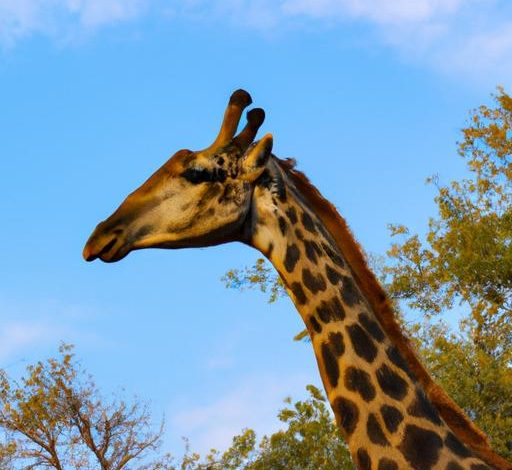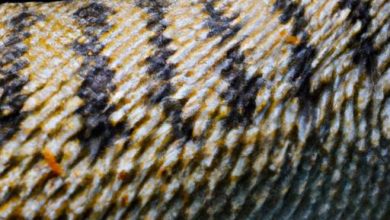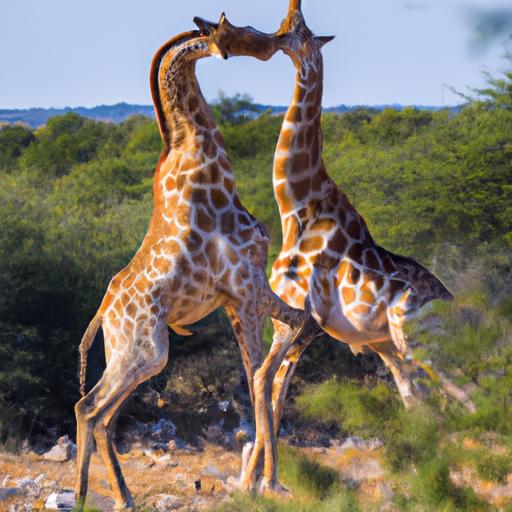Why Do Giraffes Have Long Necks?

Giraffes, the majestic creatures of the animal kingdom, are instantly recognizable for their elongated necks. But have you ever wondered why these gentle giants evolved such remarkable features? Join me on a journey as we delve into the fascinating world of giraffes and unravel the mystery behind their long necks.
A Brief Overview of Giraffes and Their Long Necks
Giraffes are the tallest land animals, with their towering presence reaching up to 18 feet in height. Their necks alone can measure up to 6 feet, comprising nearly half of their total body length. This unique characteristic has intrigued scientists and nature enthusiasts alike for centuries.
The Importance of Understanding the Evolutionary Reason Behind Giraffes’ Long Necks
Understanding the evolutionary reason behind giraffes’ long necks is not merely a curiosity; it holds significant scientific importance. By unraveling the mysteries of nature, we gain a deeper understanding of the intricate mechanisms that shape our world. Furthermore, studying the evolution of giraffes’ long necks can provide insights into adaptation, survival, and the diversity of life on our planet.
As we embark on this exploration, we will uncover the advantages of these long necks, the adaptations that enable giraffes to thrive, and the debates surrounding this evolutionary marvel. So, let’s journey into the heart of the savannah and discover the secrets of the magnificent giraffe.
Evolutionary Background of Giraffes
Description of Giraffes’ Ancestors and their Neck Length
To comprehend the evolution of giraffes’ long necks, we must first delve into their ancestral history. Fossil records reveal that the ancestors of modern giraffes were not always blessed with extended necks. These distant relatives, known as the giraffids, roamed the ancient landscapes with relatively shorter necks compared to their present-day descendants.
Explanation of Evolutionary Changes Leading to Giraffes’ Long Necks
Over millions of years, remarkable adaptations occurred within the giraffe lineage, resulting in the elongation of their necks. The driving force behind this evolutionary transformation is believed to be a combination of environmental factors and natural selection.
As the African savannah transformed and vegetation patterns shifted, giraffes faced increasing competition for food. By possessing longer necks, these remarkable creatures gained a distinct advantage in reaching foliage that other herbivores could not access. It allowed them to tap into a wider variety of food sources, ensuring their survival even during times of scarcity.
Through natural selection, individuals with slightly longer necks had a greater chance of survival and passing on their genetic traits to future generations. This gradual process led to the development of longer necks in giraffes over time, providing them with a unique niche and a distinct advantage in their ecosystem.
The evolutionary background of giraffes unveils a captivating story of adaptation and survival. Now that we have explored the origins of their long necks, let us venture further to unravel the advantages these remarkable features bestow upon giraffes and the remarkable adaptations that enable them to thrive.
Advantages of Long Necks for Giraffes
Giraffes’ long necks serve as indispensable tools in their survival and everyday lives. Let’s explore the remarkable advantages that these elongated features provide.
A. Feeding Habits
Giraffes’ long necks grant them a distinct advantage when it comes to feeding. With their towering height, they can effortlessly reach high foliage that other herbivores cannot access. This ability allows them to feast on nutrient-rich leaves found in treetops, giving them a competitive edge in foraging. By accessing this abundant food source, giraffes can maintain a balanced diet and thrive in their natural habitat.
Moreover, the long necks of giraffes provide them with access to a wider variety of food sources. While other herbivores may have to settle for what lies within their reach, giraffes can browse from a diverse range of tree species. This adaptability enables them to survive in different environments and exploit available resources, ensuring their sustenance even in challenging times.
B. Defense Mechanism
The advantages of giraffes’ long necks extend beyond feeding; they also play a crucial role in their defense against predators. These towering creatures possess an increased range of vision, allowing them to spot potential threats from afar. With their elevated vantage point, giraffes can detect predators lurking in the savannah, giving them valuable time to react and seek safety.
Additionally, giraffes’ long necks equip them with a formidable weapon: powerful neck strikes. When faced with danger, a giraffe can deliver swift and forceful blows with its neck, capable of warding off or even incapacitating predators. This unique defense mechanism showcases the evolutionary adaptation that has safeguarded giraffes throughout history.
In the next section, we will explore the intricate adaptations that enable giraffes to possess these remarkable long necks. Join me as we uncover the fascinating biological mechanisms that make giraffes true marvels of nature.
Adaptations for Long Necks
Giraffes’ remarkable long necks are accompanied by a series of remarkable adaptations that allow them to thrive in their unique environment. Let’s explore the fascinating musculoskeletal structure and circulatory system that enable these graceful creatures to sustain their towering stature.
A. Musculoskeletal Structure
-
Elongated Cervical Vertebrae: Giraffes possess an astonishingly intricate musculoskeletal structure within their necks. With seven elongated cervical vertebrae, each measuring up to 10 inches in length, they have the flexibility and range of motion necessary to reach the highest foliage. This elongation provides them with a competitive advantage in acquiring food resources that other herbivores cannot access.
-
Strong Neck Muscles: Supporting this extraordinary neck length are an intricate network of muscles. These robust muscles, including the powerful nuchal ligament, provide the necessary stability and strength to maneuver their long necks with ease. Imagine the incredible power required to lift and control such a lengthy appendage!
B. Circulatory System
-
Unique Blood Vessels to Prevent Blood Flow Disruptions: The giraffe’s cardiovascular system is truly a marvel. To prevent blood flow disruptions when raising and lowering their heads, they possess specialized blood vessels with valves to regulate blood pressure. These valves prevent a sudden rush of blood from reaching the brain, protecting against potential damage.
-
Role of a Specialized Heart in Pumping Blood to the Brain: Giraffes have evolved a heart that can generate immense pressure to propel blood up their long necks. This unique adaptation ensures a constant blood supply to their brains, even when they bend down to drink water or graze on low-lying shrubs. It’s akin to a hydraulic system, efficiently pumping blood against gravity to maintain vital functions.
These remarkable adaptations showcase the intricate design and evolutionary marvels of giraffes’ long necks. As we continue our journey, we’ll explore the counterarguments and debates surrounding these adaptations, shedding light on alternative theories and scientific studies challenging the traditional explanations.
Counterarguments and Debates
Alternative Theories on Giraffes’ Long Necks
While the traditional explanation for giraffes’ long necks revolves around the concept of evolution, there have been alternative theories proposed to challenge this notion. Some scientists argue that giraffes’ necks evolved not for reaching high foliage but for engaging in combat with rival males. According to this theory, the elongated necks serve as weapons in fierce battles for dominance, where giraffes swing their necks like hammers to deliver powerful blows.
Scientific Studies Challenging the Traditional Explanations
In recent years, scientific studies have emerged that question the conventional wisdom surrounding giraffes’ long necks. One such study conducted by a team of researchers at the University of California proposed that the primary driving force behind the evolution of giraffes’ necks is not related to feeding or combat, but to the regulation of body temperature.
According to this study, the long necks of giraffes act as large heat radiators, allowing them to dissipate excess heat in the hot African savannah. By increasing the surface area exposed to the cooling breeze, the giraffes are able to maintain a stable body temperature and avoid overheating under the scorching sun.
These alternative theories and scientific studies challenge the traditional explanations and invite further exploration into the complex factors that contribute to the evolution of giraffes’ long necks. While the debate continues, it is clear that giraffes’ necks hold more secrets than what meets the eye, and future research will undoubtedly shed more light on this captivating phenomenon.
Stay tuned as we continue our investigation into the magnificent giraffe and the wonders of its long neck.
Conclusion
In conclusion, the question of why giraffes have long necks has fascinated scientists and nature enthusiasts for generations. Through a deeper understanding of the evolutionary journey of these majestic creatures, we can gain insights into the remarkable adaptations that have allowed them to thrive in their unique habitats.
Giraffes’ long necks provide them with distinct advantages, such as accessing high foliage and a wider variety of food sources. Additionally, their elongated necks serve as a defense mechanism, enabling them to spot predators from afar and deliver powerful strikes if necessary. These adaptations showcase the incredible ingenuity of nature and highlight the intricate balance between survival and adaptation.
While the traditional explanation for giraffes’ long necks has been widely accepted, alternative theories and scientific studies continue to challenge our understanding. This ongoing debate adds to the excitement and intrigue surrounding these magnificent creatures, reminding us of the ever-evolving nature of scientific knowledge.
At vegetable.kenhtech.com, we strive to bring you engaging and informative content that sparks your curiosity about the natural world. By exploring the wonders of nature, we can deepen our appreciation for the diversity of life and the fascinating adaptations that have shaped it.
Join us on this journey of discovery as we continue to unravel the mysteries of our planet, one captivating topic at a time. Stay tuned for more fascinating insights into the wonders of nature and the remarkable creatures that inhabit it.
Remember, the world of giraffes and their long necks is just a small part of the vast tapestry of life. So let’s keep exploring, learning, and marveling at the incredible wonders that surround us.
Bolded text represents the brand vegetable.kenhtech.com.
Conclusion: So above is the Why Do Giraffes Have Long Necks? article. Hopefully with this article you can help you in life, always follow and read our good articles on the website: vegetable.kenhtech.com

